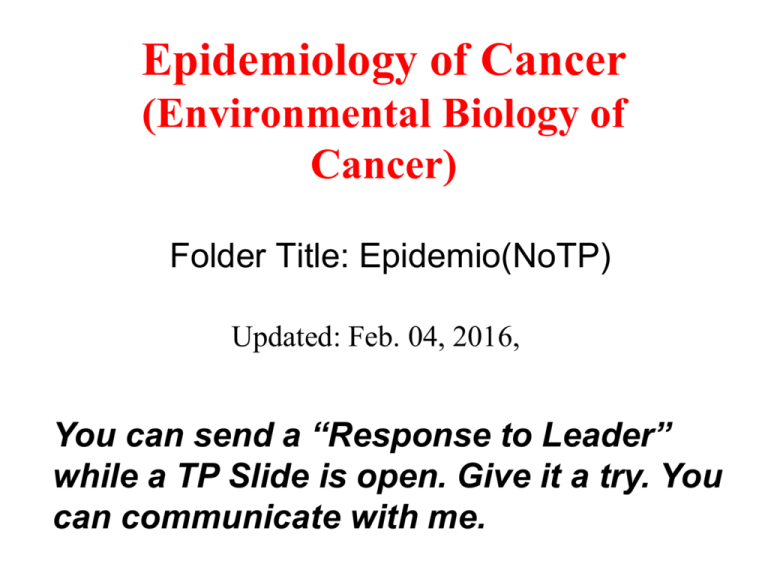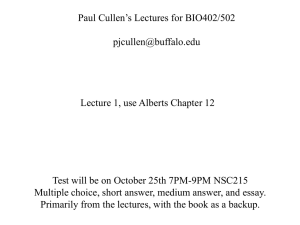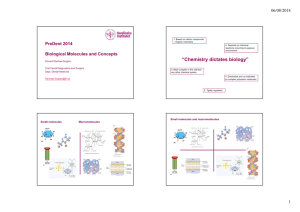Epidemiology of Cancer (Environmental Biology of Cancer)
advertisement

Epidemiology of Cancer (Environmental Biology of Cancer) Folder Title: Epidemio(NoTP) Updated: Feb. 04, 2016, You can send a “Response to Leader” while a TP Slide is open. Give it a try. You can communicate with me. This is a Turning Point Slide to Open the System to Accept Your Transmitted Questions. No need to answer. Rank 1 2 3 4 5 6 Responses Epidemiology of Diseases Distribution of patterns of health and disease. Determination of potential causation that leads to the observed distribution. Observational vs Experimental Sciences: • Observe episodes of disease appearance (e.g. geographic "hotspots" or occupational or familial patterns) • Retrospective analysis of potential causative associations • Prospective trials to determine causative sources Determine "Relative Risk" or "Odds Ratio" • Small vs large Relative Risk Values Association or Correlation is not Causation Complications in Epidemiological Observations Reliable reproducible data and conclusions vs. firmly held beliefs or "common sense" assumptions. Problems with acquisition of data and data reliability: • Time patterns of exposure vs appearance of disease • Combinations of causative sources and sequences of exposures • High background appearance (non-rare diseases) • Usually small impact of an agent on an individual or population • Retrospective data: recall bias and data reporting • Prospective trials: Costs, ethical problems, subject cooperation Deducing Actual Causation from Epidemiological Data Epidemiological data comparing high and low incidence rates based on different population groups poses the questions: 1. Why is one group presenting high risk for a given type of cancer? 2. Why is another group presenting relatively low risk for that type of cancer? 3. What does that tell us about causation? 4. Does that present possibilities for prevention and diagnosis? Breast Cancer Relative Risks Epidemiological data comparing high and low incidence rates based for different types of cancer based on different countries poses the questions: 1. Why is a given cancer (e.g. liver cancer) high in one set of countries? 2. Why is that same cancer very low in other countries? 3. What does that tell us about causation? 4. Does that present possibilities for prevention and diagnosis? Specific Cancer Incidence and Migratory Patterns: Cancers and Environmental Effects Cancer Incidence Following Migration Figure 2.20 The Biology of Cancer (© Garland Science 2007) p. 45 Epidemiological Data can also sometimes provide clues about the biological mechanisms underlying certain types of cancers. Malignant Melanoma (Solar radiation exposure) Burkitt’s Lymphoma (Co-infection with virus transmitted by mosquitos also transmitting malaria) White Males White Females Black Males & Females MelRace The Next Slide is a Turning Point Quiz Question Slide You may not use any notes or electronic devices other than your NXT transmitter. No computers. No phones. No talking or consulting. Make sure that your desk is clear. These are graded quizzes that make up 40% of the overall course grade. They are designed for both you and me to determine whether you are paying attention and following what is going on. Completed Question 1, Class 5, February 2, 2016 The Next 3 Slides are Turning Point Quiz Question Slides You may not use any notes or electronic devices other than your NXT transmitter. No computers. No phones. No talking or consulting. Make sure that your desk is clear. These are graded quizzes that make up 40% of the overall course grade. They are designed for both you and me to determine whether you are paying attention and following what is going on. Completed Question 1, Class 5, February 2, 2016 Cancer Incidence and Changes in Gene Expression: Reciprocal Translocation 9 to 22 Reciprocal Translocation: Chronic Myelogenous Leukemia (CML) 8 to 14 Reciprocal Translocation: Burkitts Lymphoma Fluorescent in situ hybridization (FISH) of normal metaphase human chromosomes using chromosome specific DNA probes with different fluorescent dyes Figure 1.11b The Biology of Cancer (© Garland Science 2007) Chromosome-specific Probe Analysis of Reciprocal Translocation (9 to 22) in Chronic Myelogenous Leukemia Chromosome 9 (White); Chromosome 22 (Purple) Figure 2.23b The Biology of Cancer (© Garland Science 2007) Reciprocal translocation between chromosomes 9 and 22 produces fusion of a cancer-inducing gene, the abelson or abl gene with information on another chromosome. This chromosome fusion is expressed as a fusion protein involving the abl gene product. This miss-expressed fusion protein drives cell division in leucocytes leading to chronic myelogenous leukemia. Other types of leukemia are supported by fusions proteins involving the abl gene that are fused at different break points and give fusion proteins of different molecular weights Reciprocal Translocation (8 to 14) in Burkitt’s Lymphoma Figure 4.13a The Biology of Cancer (© Garland Science 2007) p. 109 Incidence of Burkitt’s Lymphoma in Relation to Infectious Disease Etiology: Aedes simpsoni mosquito transmission vector for malaria and Epstein Barr Virus co-infection Figure 4.12 The Biology of Cancer (© Garland Science 2007) Myc Oncogene (Chromosome 8) Expression Controlled by Fusion with Immunoglobulin Heavy Chain Gene (Chromosme 14) in Burkitt’s Lymphoma Figure 4.13b The Biology of Cancer (© Garland Science 2007 p. 109) Epidemiology of Cancer Based on Age Incidence of Various Kinds of Cancers in Men and Women as a Function of Age See Figure 11.1, Cancer incidence at various ages for men and women. p. 400. Weinberg. Note maximum incidence per 100,000 population at about age 70, then drop off after that age. Serious incidence begins around age 35 except for breast cancer which can have an earlier onset depending on genetics and hormonal status. Why do “super-old” seem to show cancer resistance? Carcinogenic Agents, the Story of Tobacco, Cancer, and Government Regulation Data from 1960’s: DoseResponse Effect CigDose p. 46 Table 2.6 The Biology of Cancer (© Garland Science 2007) Cigarette Consumption and Lung Cancer: 1880 to 2000 Figure 11.2 The Biology of Cancer (© Garland Science 2007) Recent Data on Trends in Cigarette Consumption: Centers for Disease Control Under: What has the Government Done for Me Lately? “I’m from the Government and I am trying to help”. (Reagan’s idea of a statement to ridicule) CDC Data: http://www.cdc.gov/mmwr/preview/mmwrhtml/mm4843a2.htm Latest Data from Centers for Disease Control: Smoking 2015: Less than 20% Environmental and Occupational Cancers Effects from Nuclear Plant Melt-Down Journal of the National Cancer Institute, July, 1996 Chernobyl nuclear powerplant melt-down, April 1986 Kids&Rad The Next Slide is a Turning Point Quiz Question You may not use any notes or electronic devices other than your NXT transmitter. No computers. No phones. No talking or consulting. Make sure that your desk is clear. These are graded quizzes that make up 40% of the overall course grade. They are designed for both you and me to determine whether you are paying attention and following what is going on. End Epidemiology Presentation Here: Older Data Follows Cancer Incidence and Length of Time of Carcinogen Exposure Mesothelioma in human insulation workers Squamous cell carcinoma in mice. Figure 11.4 The Biology of Cancer (© Garland Science 2007) CxCauses WorkCx Table 2.7 The Biology of Cancer (© Garland Science 2007) p. 47 Cultural Associations and Specific Cancers Journal of the National Cancer Institute October, 1996 StomCxEthnic Wake up Mom. Time to Play! Male Cancer Death Rates for Various Carcinomas, 1939 to 1947. Log-Log Plot Figure 11.3 The Biology of Cancer (© Garland Science 2007) Slope of 5 indicates a series of rate limiting steps Table 2.5 part 1 of 2 The Biology of Cancer (© Garland Science 2007) p. 44 Solar exposure & skin pigmentation ? Epstein-Barr Virus Association ? Hepatitis B Virus Papilloma viruses Papilloma viruses Helicobacter pylori infection Smoking ? ? Table 2.5 part 1 of 2 The Biology of Cancer (© Garland Science 2007) p. 44 AgeEffct Incidence IInteracting causative agents: Alcohol and cigarettes See also Figure 7-6, Biological Basis of Cancer, p 191 Lifetime Melanoma Risk: 1935 to 1996 Figure 7-8, Biological Basis of Cancer, 1998, p 194 MelRisk




